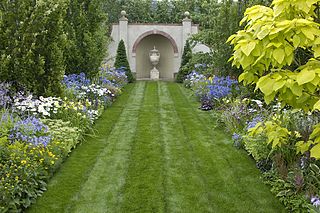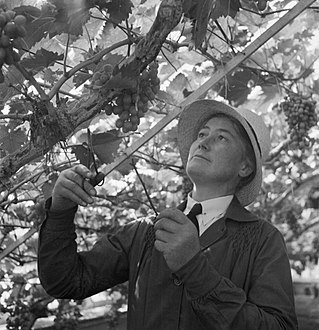Related Research Articles

The Royal Horticultural Society (RHS), founded in 1804 as the Horticultural Society of London, is the UK's leading gardening charity.

Sissinghurst Castle Garden, at Sissinghurst in the Weald of Kent in England, was created by Vita Sackville-West, poet and writer, and her husband Harold Nicolson, author and diplomat. It is among the most famous gardens in England and is designated Grade I on Historic England's register of historic parks and gardens. It was bought by Sackville-West in 1930, and over the next thirty years, working with, and later succeeded by, a series of notable head gardeners, she and Nicolson transformed a farmstead of "squalor and slovenly disorder" into one of the world's most influential gardens. Following Sackville-West's death in 1962, the estate was donated to the National Trust. It was ranked 42nd on the list of the Trust's most-visited sites in the 2021–2022 season, with over 150,000 visitors.
Sissinghurst is a small village in the borough of Tunbridge Wells in Kent, England. Originally called Milkhouse Street, Sissinghurst changed its name in the 1850s, possibly to avoid association with the smuggling and cockfighting activities of the Hawkhurst Gang. It is in the civil parish of Cranbrook and Sissinghurst.

Graham Stuart Thomas, was an English horticulturist, who is likely best known for his work with garden roses, his restoration and stewardship of over 100 National Trust gardens and for writing 19 books on gardening, many of which remain classics today. However, as he states in the Preface to his outstanding book, The Rock Garden and its Plants: From Grotto to Alpine House, "My earliest enthusiasms in gardening were for....alpines." p8

RHS Flower Show Tatton Park held at Tatton Park, near Knutsford, Cheshire, first began in 1999 by the Royal Horticultural Society. The show houses the RHS National Flower Bed Competition, Young Designer of the Year Award and a wide range of inspirational show gardens, smaller 'Back to Back' gardens, visionary gardens and a number of marquees displaying prize plants and flora exhibits. Other key features of the show are the floral marquee and plant plaza, the arts and heritage pavilion, and the floral design studio.
A plantsman is an enthusiastic and knowledgeable gardener, nurseryman or nurserywoman. "Plantsman" can refer to a male or female person, though the terms plantswoman, or even plantsperson, are sometimes used. The word is sometimes said to be synonymous with "botanist" or "horticulturist", but that would indicate a professional involvement, whereas "plantsman" reflects an attitude to plants. A horticulturist may be a plantsman, but a plantsman is not necessarily a horticulturist.
The Victoria Medal of Honour (VMH) is awarded to British horticulturists resident in the United Kingdom whom the Royal Horticultural Society Council considers deserving of special honour by the Society.

Andromeda Botanic Gardens is an organic 8-acre (3.2 ha) botanical garden and a historic cultural attraction in the village of Bathsheba, Saint Joseph in Barbados. It is an authentic garden created by multiple award-winning horticulturalist Iris Bannochie, a female, Barbadian, self-taught scientist. It is unique, having been created from the 1950s as both a private botanical garden and a pleasure garden by an individual. Named from the Greek mythological figure of Andromeda it started as a private plant collection around Ms Bannochie's home, who was also the leading expert on horticulture on the island. Ms Bannochie wrote various academic papers from topics including the lifecycle of the whistling frog, and the vitamin C content of the Barbadian cherry. She was a mentor to many and considered the queen of Barbadian horticulture. At one point, she was responsible for introducing over 90% of the ornamental plants found in Barbados. Iris Bannochie created the garden from 1954 on land owned by her family since 1740. During the 1950s Barbados was a plantation economy with no history of garden creation. Iris Bannochie travelled the world and collected plants for Andromeda. She showed plants from Andromeda both independently and with the Barbados Horticultural Society many times at the RHS Chelsea Flower Show in London, winning numerous medals. In 1982, Ms Bannochie's display was titled Andromeda Gardens at the Show and her exhibition of palms was the largest selection of that plant family ever seen at the Chelsea Flower Show. She was also the recipient of the RHS Veitch Medal and a fellow of the Linnean Society. In 1990, the garden had 40,000 visitors.
Tony Lord is a United Kingdom gardener, photographer and author. In 2005 the Royal Horticultural Society awarded him the Victoria Medal of Honour (V.M.H) for his work as a garden photographer, horticultural consultant and writer.
Frances Mary Perry MBE VMH was an English gardener, administrator, writer and broadcaster.
Penelope Hobhouse MBE, née Chichester-Clark, is a British garden writer, designer, lecturer and television presenter.

Edward Augustus Bowles was a British horticulturalist, plantsman and garden writer. He developed an important garden at Myddelton House, his lifelong home at Bulls Cross in Enfield, Middlesex and his name has been preserved in many varieties of plant. The standard author abbreviation Bowles is used to indicate this person as the author when citing a botanical name.

The Veitch Memorial Medal is an international prize issued annually by the Royal Horticultural Society (RHS).

Beatrix Havergal (1901-1980) was an English horticulturist.

Heliopsis helianthoides is a species of flowering plant in the family Asteraceae, known by the common names rough oxeye, smooth oxeye and false sunflower. It is native to eastern and central North America from Saskatchewan east to Newfoundland and south as far as Texas, New Mexico, and Georgia.

Mary Rose Spiller was an English horticulturist and teacher who devoted her life to the dissemination of successful horticulture, particularly by women, in Britain. She wrote two gardening books: Growing Fruit (1980), and Weeds, Search and Destroy (1985).
The Wild Flower Society is a society for a wide range of flower enthusiasts, from serious botanists to beginners. It arranges field trips and meetings, publishes the Wild Flower Magazine, offers prizes and has a children's section. Most members keep diaries of observations, and may photograph plants.

Waterperry Gardens are gardens with a museum in the village of Waterperry, near Wheatley, east of Oxford in Oxfordshire, England.
William Gregor MacKenzie ALS VMH (1904–1995) was a gardener and horticultural curator born in Scotland, where his father was head gardener at Ballimore, near Loch Fyne in Argyllshire.
John Craig Wallace was a horticulturalist and writer. He was Director of Parks for Belfast City Council (1972–1988) and founded the Rose Society of Northern Ireland.
References
- 1 2 3 "Pamela Schwerdt (Obituary)". The Telegraph. 25 September 2009.
- 1 2 3 Lord, Tony (6 October 2009). "Pamela Schwerdt obituary". The Guardian. Retrieved 1 July 2018.
- 1 2 3 "She led visitors up her gardens' paths". The Sydney Morning Herald. 5 October 2009. Retrieved 16 November 2018.
- ↑ "Former Sissinghurst gardener, 78, dies". Horticulture Week. 2 October 2009.
- 1 2 3 4 "Pamela Schwerdt: horticulturalist". Google Groups. The Times. 25 September 2009. Retrieved 1 July 2018.
- ↑ "RHS mourns passing of committee stalwart". The Gardeners Corner.
- ↑ "RHS honours champions of organic gardening, orchids and community horticulture". Royal Horticultural Society. 29 June 2006. Archived from the original on 1 September 2006.
- ↑ Supplement to the London gazette, 16th June 1990, The London Gazette, 16 June 1990, pp. B15
- ↑ "The International Carlo Scarpa Prize for Gardens, III Annual Award, 1992". Fondazione Benetton Studi Ricerche.
- ↑ "The Garden House". national Garden Scheme.
- ↑ "Renowned gardener died from asbestos exposure, inquest told". Cotswold Journal. 6 August 2010.
- ↑ "Horticulturist died from asbestos exposure". Wilts and Gloucestershire Standard. 7 August 2010.
- 1 2 "Get the Sissinghurst Look" (PDF), Gardens and Landscapes, p. 9, May 2018
- ↑ Gavin McEwan (13 August 2010). "Interview – Alexis Datta, head gardener, Sissinghurst Castle Gardens". Horticulture Week.